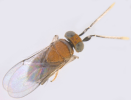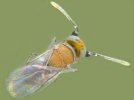 |
Scientific nameAnagyrus agraensis Saraswat
Taxonomic positionHymenoptera: Chalcidoidea: Encyrtidae: Tetracneminae
DiagnosisFemale: 1.09-1.71 mm long. Head and thorax more or less completely yellow-orange or orange; antenna with scape broadened and flattened, dark brown to black with a small white spot externally at base and a sub-apical white band, flagellum with F1 brown externally, F2 similar but the marking less extensive, F3-6 with conspicuous dark setae externally, rest of the flagellum white or yellowish; legs yellowish. Head and thorax with fine reticulate microsculpture. Wings hyaline; forewing about twice as long as broad, ventral surface of costal cell with at least two complete lines of setae,
marginal and postmarginal veins combined a little longer than stigma (Based on Noyes & Hayat, 1994; Hayat, 2006).
Male: Exhibits marked sexual dimorphism. Dorsal side more or less completely black. Antenna with flagellar segments covered with whorls of hairs. Collected commonly in association with Nipaecoccus viridis (Newstead) (Hemiptera: Pseudococcidae). ImagesDistributionIndia: Goa, Haryana, Himachal Pradesh, Karnataka, Kerala, Orissa, Punjab, Tamil Nadu, Uttar Pradesh. (Israel; Jordan (introduced); Thailand; China: Guangdong, Hainan; Indonesia: Java; Marina Is: Guam) (Hayat, 2006).
Hosts / BiologyAn important parasitoid of Nipaecoccus viridis (Newstead). Other recorded hosts include Ferrisia virgata, Planococcus citri, Rastrocococcus iceryoides, Nipaecoccus spp.,
Pseudococcus sp. and Coccidohystrix sp. on various hosts (Hayat, 2006).
Reference
|



